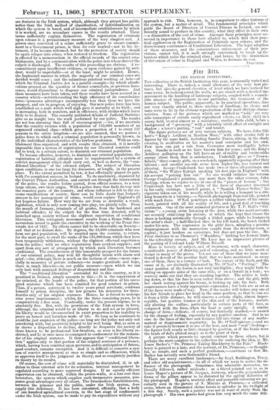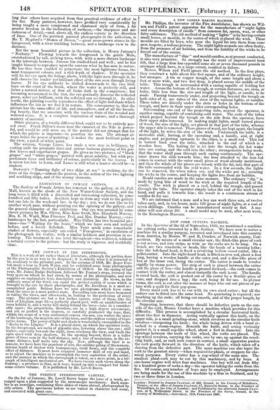lint Irto.
THE BRITISH INSTITUTION.
THE collection at the British Institution this year, is unusually varied and interesting. There is, indeed, a small allowance of the very best pic- tures, but also the general elevation of level which we have noticed for some years. In lookinground the walls, we are struck with a decided im- provement in the handling of landscape subjects, coupled with a remark- able absence of improvement in one particular, the treatment of the human subject. The public, apparently, in its practical operations, does not very exactly attend to these niceties of handling ; its choice and taste seem to lie in the obvious reproduction of the most obvious charac- teristics. Some of the pictures which are marked as "sold," are very able transcripts of certain easily reproduced effects,—a little child in a sunny field, treated almost as a miniature ; another little child, before a background of " greenery," with a tolerably vivid effect of sunlight and shadow ; a lover's parting, " real " and tender. The figure pictures are of very various subjects. We have John Gil- bert's "King's Artillery at Marston Moor," with other stories told in figures by the same hand, including Sancho Panza, sitting, in the shady evening, in meditation on his master's mad enterprise and his own. Few men can put a tale from Cervantes more intelligibly before you. Sancho is such as we have known him for years; and the King's Artillery galloping up the bill have an air of reality and businesslike energy about them that is satisfactory. Underhill gives us " Prawn- fishers," three comely girls, on a sea-beach, apparently reposing after their labours ; and another sea-side scene from higher life, less natural and pleasing. George Cruikshank has made two or three oil-paintings, one of them, " Sir Walter Raleigh smoking his first pipe in England " with his servant "putting him out." No one would criticize the veteran George Cruikshank's painting, any more than the other veteran, John Inskipp, whom we rejoice to see in one of the "places of honour" ; but Cruikshank has here not a little of the force of character discerned in his early etchings. Ansdell paints a " Spanish Flower Seller," his cigarette taken out of his mouth, while he is selling a bouquet to a stri- king brunette in a balcony,—a Spanish photograph from real life, painted with much force. O'Neil pomtrays a soldier taking leave of his sweet- heart, painted with all the reality of life, and a good deal of touching sentiment. One of the most animated pictures is Mr. T. P. Hall's "Cri • ticism " ; a young artist listening at the door, while two maid-servants are severely criticizing his picture, at which the boys that cleans the shoes is looking artistically through a folded paper, while he lounges in the artist's chair; a half-blacked shoe in his left hand, the brush tucked under his arm. The expression in the girls' faces, mingling a genuine disparagement with the mannerism caught from the drawing-room, is capital ; it just borders on caricature, but does not pass the line. Mr. Frost discloses to us Thomson's " Musidora," bathing her fervent limbs in the refreshing stream. And Mr. Lucy has an impressive picture of the parting of Lord and Lady William Russell. Here is variety of subject, and of treatment, with much character, considerable power of drawing and of colouring, and no little merit of design in many of the pieces. Yet not one of those that we have men- tioned is devoid of the peculiar fault that we have mentioned : in every one of them, there is a certain set look. The nature of the fault, and the cause of it, are distinctly illustrated by Mr. O'Neil's "Parting." The exact position of the lovers is not very intelligible ; they might both be sitting on opposite sides of the same stile, or on a thwart in a boat ; we scarcely make out that they are standing together. The soldier is look- ing down, so that his face is seen rather from above ; and the girl, with her cheek resting against his breast, is looking up into his face. Both countenances have a truly appropriate expression ; but both arc as set as if the faces were made of wax. Now, if the reader will induce any one of his fair friends to place her head in the same position, so that he can sec it from a little distance, he will observe a certain slight, almost imper- ceptible, but positive tension of the skin and of the features, materi- ally altering the outline, particularly in certain parts of the face, as compared with the form, when the head is quite upright. A similar change of form,—delicate, of course, but distinctly marked,—is caused by the change of feeling, especially by any positive emotion. And in no case do the lines of the face and features fall into forms of any mathe- matical or diagrammatic regularity. In Mr. O'Neil's picture,—and we take it precisely because it is one of the best, and most "real"-looking- the figures look nearly as little changed by position, as if the heads were the heads of dolls altered simply as to the point of view.
A picture which presents no special contrast to these others, but is perhaps the most complete in the collection for realizing the idea, is Mr. Jones Barker's "Dr. Primrose Taking Blackberry to the Fair." Black-
berry is painted to a hair, and the portrait, of Dr. Primrose,—so thought- ful, so simple, and such a perfect gentleman,--convinces us that Mr. Barker has actually seen Goldsmith's friend.
There are many excellent landscapes,—by Keyl, Boddington, Percy, and other old acquaintances,—in all of which we seem to notice the in- fluence of the photograph. Sometimes. this admirable instructor, too literally followed, rather misleads ; as a friend pointed out to us in Louis Hague's picture of St. Jacques, Antwerp, where the perpendicular forms of the pillars appear to be distorted by the optical distortion of the photograph Hague's, truthful effect and powerful colouring are pe- culiarly seen in the picture of S. Miniato at Florence,—a cathedral scene, where an illuminated shrine bursts in splendor in the twilight of a dim day. Surely, such a painter was not in want of study from the photograph ? His own genius had given him very much the same dril- ling that others have acquired from that practical evidence of effect in the flat. Many painters, however, have profited very considerably by being taught a more compressed and chastened style of form, a far greater freedom in the inclination of surffices,—the sharpness and mi- nuteness of detail,—and, aboie all, the endless variety in the direction of lines. One of the prettiest painted photographs in the collection, is Mr. T. Mogford's "Stones of Deyon,"—great moss-grown stones in the foreground, with a river trickling between, and a landscape view in the distance.
But the most beautiful picture in the collection, is Henry Jutsum's " Norbury." Flowing towards the foreground is the gentle Mole, overshadowed by tall, arching trees, with with a more distant landscape in the intervals between. Jutsum has studied hard and well ; and he has taught himself to reproduce upon the canvass what he has seen in nature. He has thus been enabled to perpetuate the most lightsome forms, the most transparent colours, and a rich depth of shadow. If the spectator will fix his eye upon the foliage above, with the light seen through it, he will observe the tender yet brilliant effect of the sun seen through living leaves. If the eye suddenly be shifted downwards to the two little bays on the coast of the brook, where the water is perfectly still, and forms a natural mirror, at first all looks dark in the comparison ; but becoming accustomed to the tint, the eye gradually discerns the reflected green, sober yet brilliant, with the reflected sun see through it. In other words, the painting exactly reproduces the effect of light and shade which influences the iris as we feel it in nature. The consequence is, that the picture has the same effect of life and atmosphere, and of all the breath- ing beauty, that we associate with the various tints of the wooded and watered scene. It is a complete inspiration of nature, and a thorough mastery of material.
Other pictures, of a totally different kind, ought not to be entirely pas- sed over. Frank Dillon's scene near the cataract of the Nile is power- ful, and would be still more so, if the painter did not attempt. that for which the palette is impotent—to pourtray the sun. The attempt al- ways belies the power of painting; it makes the most brilliant point in the view, a patch of white paint.
The veteran, George Lance, has made a new step in brilliancy, by casting aside the prismatic tints and untrue lustrous painting of his gol- den leaves and superlucent grapes. He gives us two pictures, of "black grapes" and "white grapes," painted with great sobriety, but with pro- portionate force and brilliancy of colour, particularly in the leaves. It is never too late to learn, and Lance is still what a master should be—a student.
Dawson's "Running fight of two ships at sea" is striking, for the force of the design,—almost the passion, in the action of the two fighting and scudding ships, and of the stormy elements.































 Previous page
Previous page